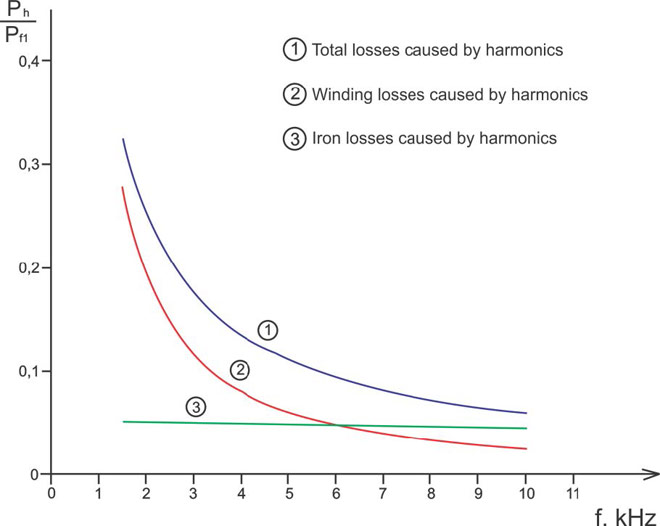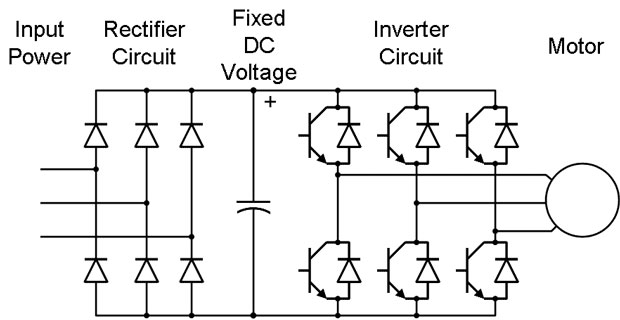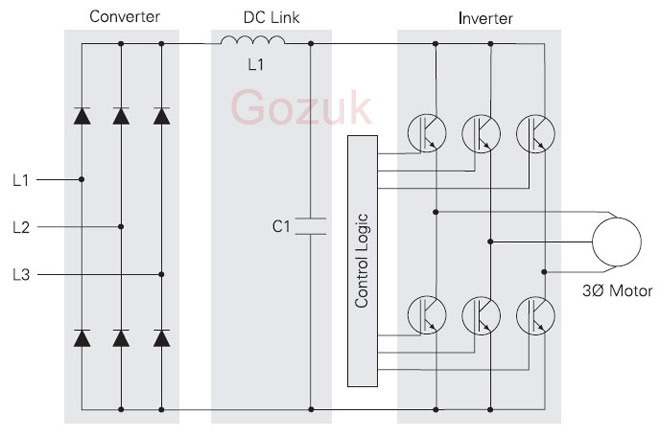VFD overcurrent protection device
An overcurrent protection device is required in the AC supply to the VFD. The purpose of this device is twofold:
The second requirement may be met with either the instantaneous trip function of a circuit breaker or a fuse. The total amount of energy let through in the event of a short circuit or near short circuit event is usually the critical factor in determining the injury risk, extent of physical damage and consequently the time and expense involved in repair. The let through energy may be accessed in terms of the I2t (time integral of current squared) let through the protective device in the process of interrupting the fault current. In order to minimize the I2t let through and the associated risks of injury, property damage and downtime, we recommend the use of appropriately rated current limiting3 type fuses. In some circumstances, the user's protection needs may be met by a suitably selected circuit breaker however, we strongly recommend that any such selection be based on detailed engineering evaluation and not simply a catalogue selection.
- To provide thermal protection for the VFD cables etc between the location of the overcurrent protective device (usually at the origin of the relevant supply sub-circuit) and the VFD. This is predominantly a measure to prevent injury and property damage from melting and fire.
- To limit the energy available at the location of a short circuit or near short circuit in the unlikely, but possible, event of a major arcing fault in wiring or within the VFD enclosure. This measure is to control the risk of personal injury and property damage due to arc flash, conductor erosion, explosion and the like.
The second requirement may be met with either the instantaneous trip function of a circuit breaker or a fuse. The total amount of energy let through in the event of a short circuit or near short circuit event is usually the critical factor in determining the injury risk, extent of physical damage and consequently the time and expense involved in repair. The let through energy may be accessed in terms of the I2t (time integral of current squared) let through the protective device in the process of interrupting the fault current. In order to minimize the I2t let through and the associated risks of injury, property damage and downtime, we recommend the use of appropriately rated current limiting3 type fuses. In some circumstances, the user's protection needs may be met by a suitably selected circuit breaker however, we strongly recommend that any such selection be based on detailed engineering evaluation and not simply a catalogue selection.
Post a Comment:
You may also like:
Featured Articles
Variable frequency drive Rectifier
 To understand variable frequency drive (VFD) better, it's necessary to explain some of the main parts of the variable frequency ...
To understand variable frequency drive (VFD) better, it's necessary to explain some of the main parts of the variable frequency ...
 To understand variable frequency drive (VFD) better, it's necessary to explain some of the main parts of the variable frequency ...
To understand variable frequency drive (VFD) better, it's necessary to explain some of the main parts of the variable frequency ...VFD controlled Induction motor ...
 This paper presents a procedure to measure the efficiency on an induction motor fed by a VFD by the all operation range to speed ...
This paper presents a procedure to measure the efficiency on an induction motor fed by a VFD by the all operation range to speed ...
 This paper presents a procedure to measure the efficiency on an induction motor fed by a VFD by the all operation range to speed ...
This paper presents a procedure to measure the efficiency on an induction motor fed by a VFD by the all operation range to speed ...What is VFD, How it works? - VFD ...
 VFD is shorted for Variable Frequency Drive (also known as AC Drives and Inverters) -- that's used to make an AC motor working in ...
VFD is shorted for Variable Frequency Drive (also known as AC Drives and Inverters) -- that's used to make an AC motor working in ...
 VFD is shorted for Variable Frequency Drive (also known as AC Drives and Inverters) -- that's used to make an AC motor working in ...
VFD is shorted for Variable Frequency Drive (also known as AC Drives and Inverters) -- that's used to make an AC motor working in ...VFD: Pulse Width Modulation (PWM)
 Pulse Width Modulation (PWM) VFDs provide a more sinusoidal current output to control frequency and voltage supplied to an AC ...
Pulse Width Modulation (PWM) VFDs provide a more sinusoidal current output to control frequency and voltage supplied to an AC ...
 Pulse Width Modulation (PWM) VFDs provide a more sinusoidal current output to control frequency and voltage supplied to an AC ...
Pulse Width Modulation (PWM) VFDs provide a more sinusoidal current output to control frequency and voltage supplied to an AC ...Variable frequency drive Advantages & ...
VFDs are good for variable speed, in a water pump this is used to maintain a steady pressure, they will smooth out variances in ...

VFD manufacturers
